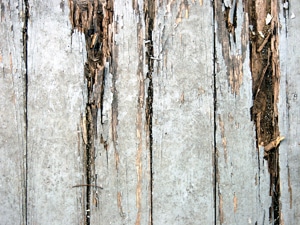Hope I’m not talking rot…..
It’s summer, so I thought I’d write about wet rot.
Poor preparation and painting (and neglect) of timber door and window frames is bad news for your property, but it’s good news for fungi. Poor painting means your wood gets wet, and wet wood gives fungus both a hearty meal and a cosy home.
In fact our moist and moderate climate is very fungus-friendly, so decorating work has to be good to keep them out. The old lead-based paints did the job very well, and lasted well. And the old culture of apprenticeships taught workmen to use plenty of elbow-grease in preparing surfaces. Getting rid of lead paint was a good idea, but apprenticeships ……. don’t get me started.
I thought you might like to know a bit about rot. It can cost a fortune to get rid of, so it’s worth being able to act before it gets stuck in.
There are two main types of rot: wet and dry. The names are slightly misleading as water is an essential element for any fungi to thrive: wet rot likes a moisture content over 24%, dry rot will come in with moisture levels above 18%. Both types are a form of fungus. There are several different types of Wet Rot, but the main ones are white and brown, which damage wood in different ways. The spores for timber fungi are in the air, in the same way as pollen and mould.

Warning signs of dry rot
The rot eats the nutrients in the timber, causing large cracks as it consumes the strength and fibres. When the initial food source is exhausted the strands of rot can travel through masonry and between plaster and brickwork, in search of the next square meal.
Brown rot causes cracking and shrinkage, and timber becomes very weak: it can even be broken up by hand once the attack has developed. It can be identified by the darkening it causes. White rot causes a lightening of the timber, and you can see damage along the grain.

Effects of wet rot
What is a fungus?
You might like to know that a fungus is a member of a large group of organisms including yeasts and moulds, as well as mushrooms. These organisms are classified as a kingdom separate from plants, animals, and bacteria, though genetic studies have shown they are more closely related to animals than to plants. Fungal cells have walls that contain chitin (a derivative of glucose), unlike the cell walls of plants, which contain cellulose.
Cellulose (since you ask) is the most abundant organic polymer on Earth. The cellulose content of cotton fiber is 90%, wood 40–50%, and dried hemp around 45%. Some animals, particularly ruminants and termites, digest cellulose with the help of micro-organisms that live in their guts. Humans can digest cellulose to some extent, however it mainly acts as a bulking agent and is often referred to as “dietary fiber”.
Which brings me back to decorating.
Decorating won’t get rid of dry rot, but we frequently have to repair window and door frames damaged by wet rot. Cowboy decorators (see my last post on Oikodomophobia) will often cover up wet rot with filler and a coast of gloss. If they leave some rotten wood behind, the rot eats into the new wood and before long you see bumps, blistering and cracking in the new paintwork. Getting out all the rot isn’t easy – hence my comments about elbow-grease. And the hole left behind means a bit of carpentry is needed rather than just a tin of filler. But if the job is done properly (the way my father used to tell me to do it) then it is virtually as sound as a new frame.
Despite what my better half Holly says, I am not really an expert on rot. My workmen may complain that I’m not happy unless I see beads of sweat on their brow, but I do like to see things done properly. Am I starting to go on again?
All the best
Geoff Parvin

